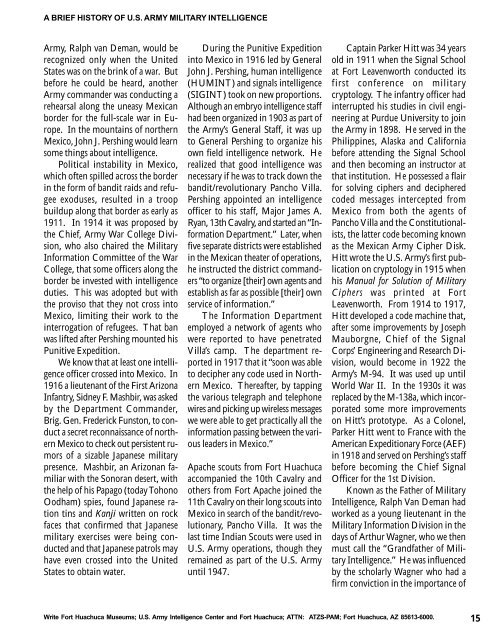Brief History of Army MI - Fort Huachuca - U.S. Army
Brief History of Army MI - Fort Huachuca - U.S. Army
Brief History of Army MI - Fort Huachuca - U.S. Army
You also want an ePaper? Increase the reach of your titles
YUMPU automatically turns print PDFs into web optimized ePapers that Google loves.
A BRIEF HISTORY OF U.S. ARMY <strong>MI</strong>LITARY INTELLIGENCE<strong>Army</strong>, Ralph van Deman, would berecognized only when the UnitedStates was on the brink <strong>of</strong> a war. Butbefore he could be heard, another<strong>Army</strong> commander was conducting arehearsal along the uneasy Mexicanborder for the full-scale war in Europe.In the mountains <strong>of</strong> northernMexico, John J. Pershing would learnsome things about intelligence.Political instability in Mexico,which <strong>of</strong>ten spilled across the borderin the form <strong>of</strong> bandit raids and refugeeexoduses, resulted in a troopbuildup along that border as early as1911. In 1914 it was proposed bythe Chief, <strong>Army</strong> War College Division,who also chaired the MilitaryInformation Committee <strong>of</strong> the WarCollege, that some <strong>of</strong>ficers along theborder be invested with intelligenceduties. This was adopted but withthe proviso that they not cross intoMexico, limiting their work to theinterrogation <strong>of</strong> refugees. That banwas lifted after Pershing mounted hisPunitive Expedition.We know that at least one intelligence<strong>of</strong>ficer crossed into Mexico. In1916 a lieutenant <strong>of</strong> the First ArizonaInfantry, Sidney F. Mashbir, was askedby the Department Commander,Brig. Gen. Frederick Funston, to conducta secret reconnaissance <strong>of</strong> northernMexico to check out persistent rumors<strong>of</strong> a sizable Japanese militarypresence. Mashbir, an Arizonan familiarwith the Sonoran desert, withthe help <strong>of</strong> his Papago (today TohonoOodham) spies, found Japanese rationtins and Kanji written on rockfaces that confirmed that Japanesemilitary exercises were being conductedand that Japanese patrols mayhave even crossed into the UnitedStates to obtain water.During the Punitive Expeditioninto Mexico in 1916 led by GeneralJohn J. Pershing, human intelligence(HU<strong>MI</strong>NT) and signals intelligence(SIGINT) took on new proportions.Although an embryo intelligence staffhad been organized in 1903 as part <strong>of</strong>the <strong>Army</strong>’s General Staff, it was upto General Pershing to organize hisown field intelligence network. Herealized that good intelligence wasnecessary if he was to track down thebandit/revolutionary Pancho Villa.Pershing appointed an intelligence<strong>of</strong>ficer to his staff, Major James A.Ryan, 13th Cavalry, and started an “InformationDepartment.” Later, whenfive separate districts were establishedin the Mexican theater <strong>of</strong> operations,he instructed the district commanders“to organize [their] own agents andestablish as far as possible [their] ownservice <strong>of</strong> information.”The Information Departmentemployed a network <strong>of</strong> agents whowere reported to have penetratedVilla’s camp. The department reportedin 1917 that it “soon was ableto decipher any code used in NorthernMexico. Thereafter, by tappingthe various telegraph and telephonewires and picking up wireless messageswe were able to get practically all theinformation passing between the variousleaders in Mexico.”Apache scouts from <strong>Fort</strong> <strong>Huachuca</strong>accompanied the 10th Cavalry andothers from <strong>Fort</strong> Apache joined the11th Cavalry on their long scouts intoMexico in search <strong>of</strong> the bandit/revolutionary,Pancho Villa. It was thelast time Indian Scouts were used inU.S. <strong>Army</strong> operations, though theyremained as part <strong>of</strong> the U.S. <strong>Army</strong>until 1947.Captain Parker Hitt was 34 yearsold in 1911 when the Signal Schoolat <strong>Fort</strong> Leavenworth conducted itsfirst conference on militarycryptology. The infantry <strong>of</strong>ficer hadinterrupted his studies in civil engineeringat Purdue University to jointhe <strong>Army</strong> in 1898. He served in thePhilippines, Alaska and Californiabefore attending the Signal Schooland then becoming an instructor atthat institution. He possessed a flairfor solving ciphers and decipheredcoded messages intercepted fromMexico from both the agents <strong>of</strong>Pancho Villa and the Constitutionalists,the latter code becoming knownas the Mexican <strong>Army</strong> Cipher Disk.Hitt wrote the U.S. <strong>Army</strong>’s first publicationon cryptology in 1915 whenhis Manual for Solution <strong>of</strong> MilitaryCiphers was printed at <strong>Fort</strong>Leavenworth. From 1914 to 1917,Hitt developed a code machine that,after some improvements by JosephMauborgne, Chief <strong>of</strong> the SignalCorps’ Engineering and Research Division,would become in 1922 the<strong>Army</strong>’s M-94. It was used up untilWorld War II. In the 1930s it wasreplaced by the M-138a, which incorporatedsome more improvementson Hitt’s prototype. As a Colonel,Parker Hitt went to France with theAmerican Expeditionary Force (AEF)in 1918 and served on Pershing’s staffbefore becoming the Chief SignalOfficer for the 1st Division.Known as the Father <strong>of</strong> MilitaryIntelligence, Ralph Van Deman hadworked as a young lieutenant in theMilitary Information Division in thedays <strong>of</strong> Arthur Wagner, who we thenmust call the “Grandfather <strong>of</strong> MilitaryIntelligence.” He was influencedby the scholarly Wagner who had afirm conviction in the importance <strong>of</strong>Write <strong>Fort</strong> <strong>Huachuca</strong> Museums; U.S. <strong>Army</strong> Intelligence Center and <strong>Fort</strong> <strong>Huachuca</strong>; ATTN: ATZS-PAM; <strong>Fort</strong> <strong>Huachuca</strong>, AZ 85613-6000.15
















